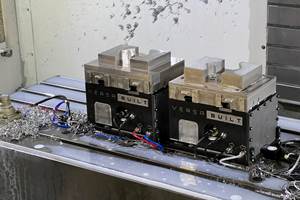Pump Maker Gains Production Efficiency With Smart Gaging Choices
The challenge facing this pump manufacturer was to make the high-tolerance inspection process so efficient that parts could be checked randomly by several machinists, without causing delays that would slow production.
Share





Haldex Barnes Corp. (Rockford, Illinois) manufactures hydraulic gear pumps (including the W Series) and fluid motors that are used in material handling, turf and construction equipment, as well as other applications. Three product families, each with a different aluminum housing, form the basis for a wide range of submodels. The aluminum housings include numerous machined features, including two bearing bores, four dowel pin bores, two overlapping gear pockets, tapped inlet and outlet ports, and precision upper and lower faces. Most of these features have tight tolerances and geometric dimensioning for out of roundness, distances between centers, flatness and parallelism of faces, pocket depth and more.
Haldex machinists need to check many of these features during setups and periodically during production to maintain process control. Because the need for inspection at this stage of production is periodic, not constant, Haldex determined that a single shopfloor gaging station, equally accessible to machinists working on all three product families, would serve the need. The trick, however, was to make the inspection process so efficient that parts from the three families could be checked randomly by several machinists, without causing delays that would slow production.
“We considered a ¸ßĹâÂĘÁůşĎ˛Ę for the application, but that wasn’t practical,” says Haldex Barnes gage calibration technician Deb Miller. “The shopfloor environment where we perform the measurements isn’t conducive to ¸ßĹâÂĘÁůşĎ˛Ę reliability, and taking the parts out of the production area to a stable environment would be terribly inefficient. ¸ßĹâÂĘÁůşĎ˛Ęs are also too slow to measure these parts efficiently, and most of them just aren’t accurate enough for our needs.”
So Haldex Barnes contacted Mahr Federal Inc. (Providence, Rhode Island), which responded with three custom engineered bench fixture gages, connected to a single FedCheck Gaging Computer/Software package. A Mahr Federal air plug gage, whose use is common to all three parts, is also connected to the computer through an air to electronic conversion module.
All four gages sit side by side on the bench, with the computer on a shelf above. When a machinist needs to measure a part, he or she begins by selecting the appropriate part program from a screen menu on the FedCheck. The computer displays the part image, with all relevant tolerance specifications.
The operator inserts the air plug into a dowel bore, and the FedCheck records the inside diameter measurement. Then the operator turns the plug 90 degrees for a second ID reading, and the computer calculates a twopoint out of roundness value from the difference between the two measurements. The second dowel bore on that side of the part is measured the same way.
Next, the part is placed on the appropriate bench fixture, using the dowel bores as references. Each fixture has seven LVDTtype transducers contacting various part features, either directly or through linkages. The computer uses some of the LVDT signals in isolation, and combines others mathematically, to capture and/or calculate values for two gear pocket diameters; center distance between two dowel bores; and position of the two gear bores relative to the dowel bores. The part is then flipped over, a similar series of measurements is performed on the reverse side, and the two sides are compared.
The FedCheck displays all the dimensions simultaneously in “column gage” format. Because the columns change color, depending upon whether a dimension is in or out of tolerance, the operator need only glance at the computer screen to confirm that production remains in tolerance. If a part does contain an out of tolerance condition, the operator has the option of printing out a summary sheet of all the part’s dimensions; this is tagged to the part for future analysis.
According to Ms. Miller, it takes less than 20 seconds to measure 27 critical dimensions using the multistation gage. Consequently, the single gaging station is able to efficiently serve the shopfloor quality control needs for the entire W Series product line, enabling operators to return to their machines without delay. The system provides high accuracy and 100 percent capture of data for quality documentation, helping the company maintain overall quality, as well as ISO 9001 certification. ¸ßĹâÂĘÁůşĎ˛Ę
Related Content
Studer's Automation, Entry-Level Solutions Take Center Stage
At its 2024 Music Motion Meeting, Studer AG showed off its entry-level line of grinding machines, as well as its newest universal loading system.
Read MoreUsing Jaws as Grippers Enables Flexible, Low-Cost Automation
VersaBuilt’s automation systems significantly boosted Innovative Fabrication’s revenue. In return, the shop has helped VersaBuilt optimize its products.
Read MoreLean Approach to Automated Machine Tending Delivers Quicker Paths to Success
Almost any shop can automate at least some of its production, even in low-volume, high-mix applications. The key to getting started is finding the simplest solutions that fit your requirements. It helps to work with an automation partner that understands your needs.
Read MoreMedical Shop Performs Lights-Out Production in Five-Axes
Moving to five-axis machining enabled this shop to dramatically reduce setup time and increase lights-out capacity, but success relied on the right combination of workholding and automation.
Read MoreRead Next
Machine Shop MBA
Making Chips and ¸ßĹâÂĘÁůşĎ˛Ę are teaming up for a new podcast series called Machine Shop MBA—designed to help manufacturers measure their success against the industry’s best. Through the lens of the Top Shops benchmarking program, the series explores the KPIs that set high-performing shops apart, from machine utilization and first-pass yield to employee engagement and revenue per employee.
Read MoreAMRs Are Moving Into Manufacturing: 4 Considerations for Implementation
AMRs can provide a flexible, easy-to-use automation platform so long as manufacturers choose a suitable task and prepare their facilities.
Read More




















